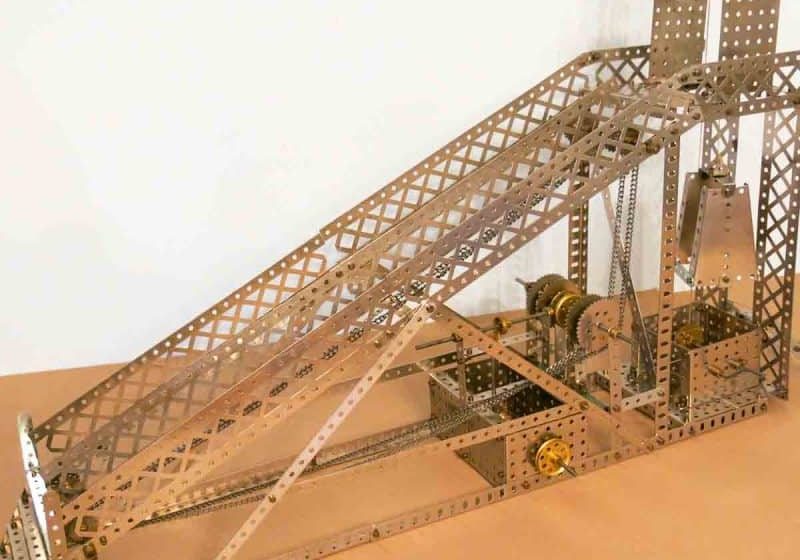Delaware Elevator provides replica Prohibition-era unit for Seacrets Distillery in Ocean City, Maryland.
The Seacrets Distilling Co. building may be new, but step into its elevator, and it’s easy to imagine it filled with cigar smoke and populated with the stylish flappers and bootleggers who were part of Ocean City, Maryland’s past. That’s by design: working with the local office of Delaware Elevator Inc., Seacrets owner Leighton Moore scoured the country to find antique components — door panels, car operating panels (COPs), position indicators, an emergency phone — to replicate a Prohibition Era elevator.
Moore wanted a hardworking showpiece elevator, one that could quickly and quietly transport both inventory and scores of people daily a distance of 40 ft., 9 in. The elevator was delivered on June 28, 2016, to coincide with the distillery’s grand opening on June 30. “Erected in 2016, Seacrets Distillery marks a new milestone for the town of Ocean City, as the first distillery built in Worcester County since the end of Prohibition in 1933,” Seacrets Distilling states.
Wedding form and function, the elevator is the result of nearly a year of planning and an eight-week installation schedule that Delaware Elevator went out of its way to meet. From architects and engineers to a long list of suppliers, the elevator is a testament to communication and teamwork.
Delaware Elevator Chief Executive Officer Pete Meeks spoke with ELEVATOR WORLD about the project, explaining that preliminary design work began in 2015 when Moore and architect/engineer Keith Lott contacted the company. “They reached out to us early on to discuss design and function, since this elevator would serve a working distillery and also as a public attraction used daily,” Meeks says, elaborating:
“The elevator entailed a large, freight-type cab, approximately 10 ft. tall with 8- to 9-ft.-wide, two-speed, heavy-duty, center-opening doors, and entrances, hoistway sills and door sills with a bronze patina finish. The shell of the cab was engineered to accommodate many different architectural and aesthetic finishes to replicate a service elevator from the Prohibition Era. The wall panels were modified to accommodate ornate, antique door panels that [Moore] scoured the country for and obtained specifically for this project. The panels include frosted glass illuminated by fiber-optic lights in the shaft.”
With guidance from Moore and C.J. Anderson & Co., Delaware Elevator designed and ordered antique replica COPs for the front and rear of the cab, hall lanterns and position indicators. These components have a distressed bronze finish and shapes that echo the design of the day. The Seacrets logo was etched into the COPs. Moore also requested that Delaware Elevator order an ornate, replica half-moon position indicator with a working mechanical arm. The attention to detail did not stop there. Meeks elaborates:
“Throughout the elevator, there are antique brass elements, such as a cab phone and other authentic memorabilia. One of the items the owner found was an antique bronze-cased potentiometer, which was used in earlier days to adjust and provide needed electricity to an elevator when there was not enough power in the building. This was mounted right outside the first-floor landing adjacent to an antique bronze key box. The elevator also has a 3/4-in.-thick oak tongue-and-groove finished floor that goes with the décor and is the type of floor that would have been used during that era.”
Meeks says the tight timeframe was the most challenging aspect of the Seacrets project, one that was overcome by working multiple crews on multiple shifts. The Delaware Elevator team also had to work with other contractors. “Like many other fast-track projects, there were multiple trades working simultaneously to achieve the desired completion date,” Meeks says.
Teamwork among the trades, and also the individuals involved, was key to a successful outcome. In addition to all the other antique elements, Meeks donated a Delaware Elevator bronze logo plate from an elevator installed by his grandfather in a building in Wilmington, Delaware, in the 1930s.
The unit is a DEM-7000IG model, in-ground passenger hydraulic elevator with a capacity of 5000 lb. that travels at 100 fpm. It stops at four landings. Its platform is 8 ft. wide and 8 ft., 5 in. deep.
Delaware Elevator was responsible for engineering, design, project management and hardware such as bracketry, car frame, sling, platform, jacks and the power unit. In addition to C.J. Anderson, which also supplied antique push buttons, the following suppliers were involved:
- Controls: Virginia Controls Inc.
- Cab shell: Capital Elevator Co.
- Doors: Columbia Elevator Products Co. Inc.
- Door-operating equipment: GAL/Hollister-Whitney
- Well-hole drilling: Chesapeake Drilling Corp.
Key players from Delaware Elevator included Frank Giampa, engineering; Jose Carrasco, construction manager; Justin Fulmer, superintendent; Dan Bohn, construction coordinator; and Shane Riggs, foreman.
Get more of Elevator World. Sign up for our free e-newsletter.









